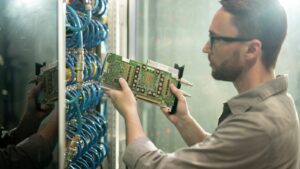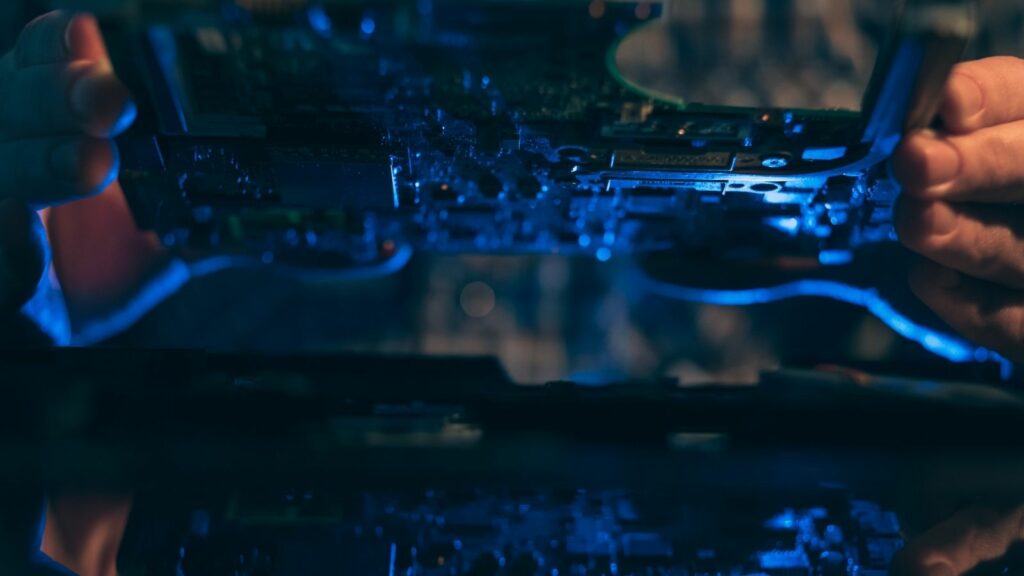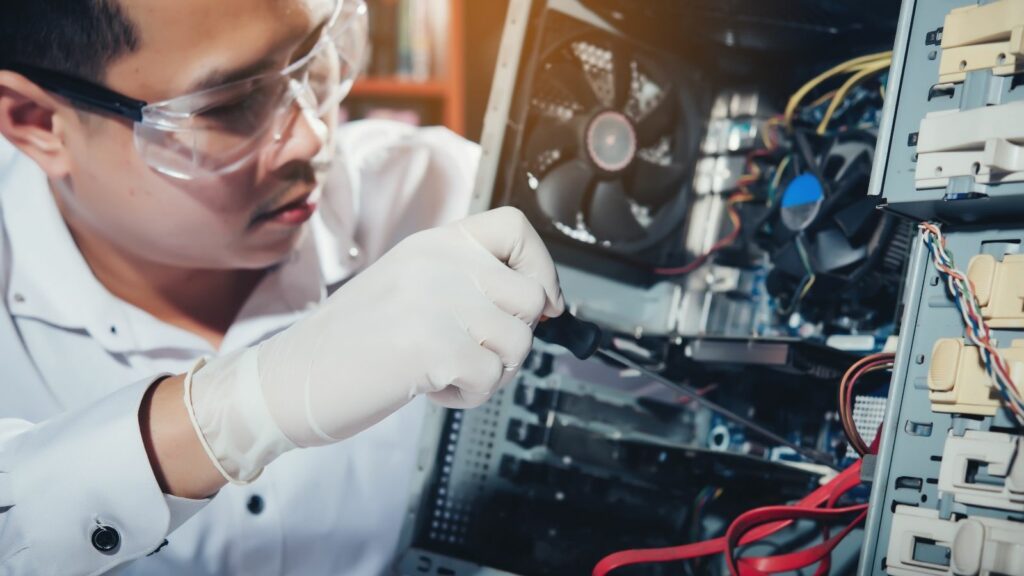Key Takeaways
- Safety First: Always power off and unplug the device before starting any hardware work to prevent electrical shock and short circuits.
- Grounding Techniques: Ground yourself using anti-static wristbands or by touching grounded metal to avoid damaging sensitive components through static electricity discharge.
- Tool Preparation: Ensure you have the necessary tools, such as screwdrivers, anti-static wristbands, and cleaning supplies, organized and ready for use.
- Workspace Organization: Maintain a clean and clutter-free workspace to enhance focus and minimize accidents during hardware modifications.
- Understand Specifications: Familiarize yourself with the system’s specifications and compatibility requirements before making any hardware changes to prevent costly mistakes.
- Documentation Use: Review repair guides and tutorials to follow best practices and ensure a safe and effective hardware modification process.
Before diving into hardware work on a computer system, it’s crucial to follow a few essential safety protocols. Whether it’s upgrading components or performing repairs, taking the right precautions can prevent damage to both the hardware and the user. Understanding these steps not only enhances the longevity of the equipment but also ensures a smooth and efficient workflow.
Many users overlook the importance of preparation, leading to potential mishaps or costly errors. From grounding oneself to avoid static discharge to ensuring the system is powered down, these preliminary actions are vital. This article explores the key steps to take before tackling any hardware-related tasks, empowering users with the knowledge to work confidently and safely.
Which Of The Following Should Be Done Before Working On Hardware In A Computer System?
 Pre-work procedures play a critical role in maintaining computer hardware integrity. Performing these procedures minimizes risks related to static electricity and accidental power surges. Grounding oneself serves as a protective measure against static discharge, which can damage sensitive components inside the computer.
Pre-work procedures play a critical role in maintaining computer hardware integrity. Performing these procedures minimizes risks related to static electricity and accidental power surges. Grounding oneself serves as a protective measure against static discharge, which can damage sensitive components inside the computer.
Ensuring the system is powered down prevents electrical faults during hardware modifications. This procedure avoids potential short circuits that can harm both the hardware and the user. Disconnecting all peripheral devices, including monitors and keyboards, further reduces risks associated with accidental power supply issues.
Confirming that the workspace is clean and organized enhances efficiency and safety. It prevents clutter-induced accidents and provides easy access to tools, allowing for swift hardware upgrades or repairs. Utilizing tools designed specifically for computer hardware, such as anti-static wristbands, demonstrates an understanding of safe handling procedures.
Following these pre-work steps fosters a secure environment for any hardware work. The adherence to these protocols establishes a foundation for effective and responsible hardware management.
Safety Precautions
Observing safety precautions is vital before working on computer hardware. These practices prevent damage and ensure a secure working environment.
Power Off the Device
Always power off the device prior to any hardware work. Turning off the computer eliminates risks of electrical shock and accidental short circuits. It ensures that no current flows through the system, safeguarding both the hardware components and the individual performing the work. Unplugging the device from its power source further reduces the chance of accidental power surges during maintenance.
Grounding Yourself
Grounding oneself is essential to prevent static electricity buildup and discharge. Static electricity can damage sensitive computer components. Users should employ grounding techniques such as wearing anti-static wristbands and touching a grounded metal object, like the computer case. These measures create a safe environment by dissipating static charge safely, protecting the hardware from potential harm during the work process.
Tools and Equipment Preparation
Preparing the right tools and organizing the workspace are vital steps before working on computer hardware. Proper tools enhance efficiency and safety during the process.
Necessary Tools Checklist
- Screwdrivers: Utilize both Phillips and flat-head screwdrivers for various hardware components.
- Anti-Static Wristband: Wear an anti-static wristband to prevent static electricity discharge that can damage sensitive parts.
- Pliers: Use pliers for gripping or bending wires and components during installation or removal.
 Tweezers: Employ tweezers for precise handling of small components, especially in tight spaces.
Tweezers: Employ tweezers for precise handling of small components, especially in tight spaces.- Thermal Paste: Keep thermal paste ready for reapplying when changing CPUs or heatsinks.
- Cleaning Supplies: Include microfiber cloths and isopropyl alcohol for cleaning components.
- Cables: Prepare various types of cables (SATA, power cables) required for component connections.
- Flashlight: Use a flashlight for better visibility in dark areas of the system case.
- Clear Surface: Maintain a clutter-free surface to minimize distractions and enhance focus during hardware work.
- Designate Areas: Allocate specific areas for tools and components to streamline the workflow and avoid misplacement.
- Label Storage: Use labeled containers or bags for storing screws and small parts, ensuring easy access during assembly.
- Good Lighting: Ensure adequate lighting in the workspace to easily see small components and connections.
- Check Power Source: Verify that the workspace has access to power outlets for necessary tools, such as soldering irons.
- Remove Unnecessary Items: Keep unrelated items out of the workspace to prevent accidents and maintain organization.
Following this preparation ensures a successful and safe hardware work experience.
Documentation and Research
Before engaging in hardware work, proper documentation and research are essential. Understanding system specifications and repair guides helps ensure effective modifications while minimizing risks.
Understanding the System Specifications
Understanding system specifications involves knowing the hardware components and their compatibility. Users should collect detailed information about the central processing unit (CPU), motherboard, memory (RAM), storage options, and power supply unit (PSU). Checking the manufacturer’s documentation or the system’s manual provides crucial details such as maximum hardware capacities and required connectors. This knowledge prevents the purchase of incompatible components, reducing wastage and errors during installation.
Reviewing Repair Guides
Reviewing repair guides offers step-by-step instructions for specific hardware tasks. Users can find guides from reputable sources, including manufacturer websites and specialized forums. Detailed guides contain troubleshooting tips, diagrams, and safety warnings for particular hardware replacements or upgrades. Engaging with video tutorials can provide a visual understanding of the process. Utilizing these resources ensures users follow best practices and achieve successful hardware modifications safely.
Computer Hardware Is Vital For Safety And Efficiency
Taking the right steps before working on computer hardware is vital for safety and efficiency. Grounding oneself and powering down the system are fundamental practices that protect both the user and the components. Maintaining a clean and organized workspace further enhances safety and productivity.
Equipping oneself with the appropriate tools and consulting reliable resources ensures a smoother hardware modification experience. With these preparations in place, users can confidently approach their hardware projects while minimizing risks and maximizing success. Prioritizing these essential steps lays the groundwork for effective hardware management and fosters a safer working environment.



